Partnership Act 1891: Analysis of Legal Issues and Case Law
VerifiedAdded on 2020/03/16
|10
|1967
|206
Homework Assignment
AI Summary
This assignment presents a legal analysis of a business partnership case, examining several key issues under the Partnership Act 1891. The analysis begins by determining whether a partnership exists between Shaun and Craig, considering factors such as business operations, financial contributions, and the intent to share profits. Assuming a partnership is established, the assignment then explores whether Craig properly dissolved the partnership, assessing the requirements for providing notice. Further issues addressed include Craig's entitlement to income from extra lessons, the classification of music instruments and equipment as partnership property, and the liability for outstanding rent and electricity. Finally, the analysis determines who is liable if a third party successfully sues the partnership. Each issue is addressed by referencing relevant sections of the Partnership Act 1891, along with supporting case law. The assignment concludes with a bibliography of sources used, including legislation, case law, and online resources. The assignment provides a comprehensive overview of the legal principles governing partnerships, and it provides a practical application of the law to a real-world business scenario.
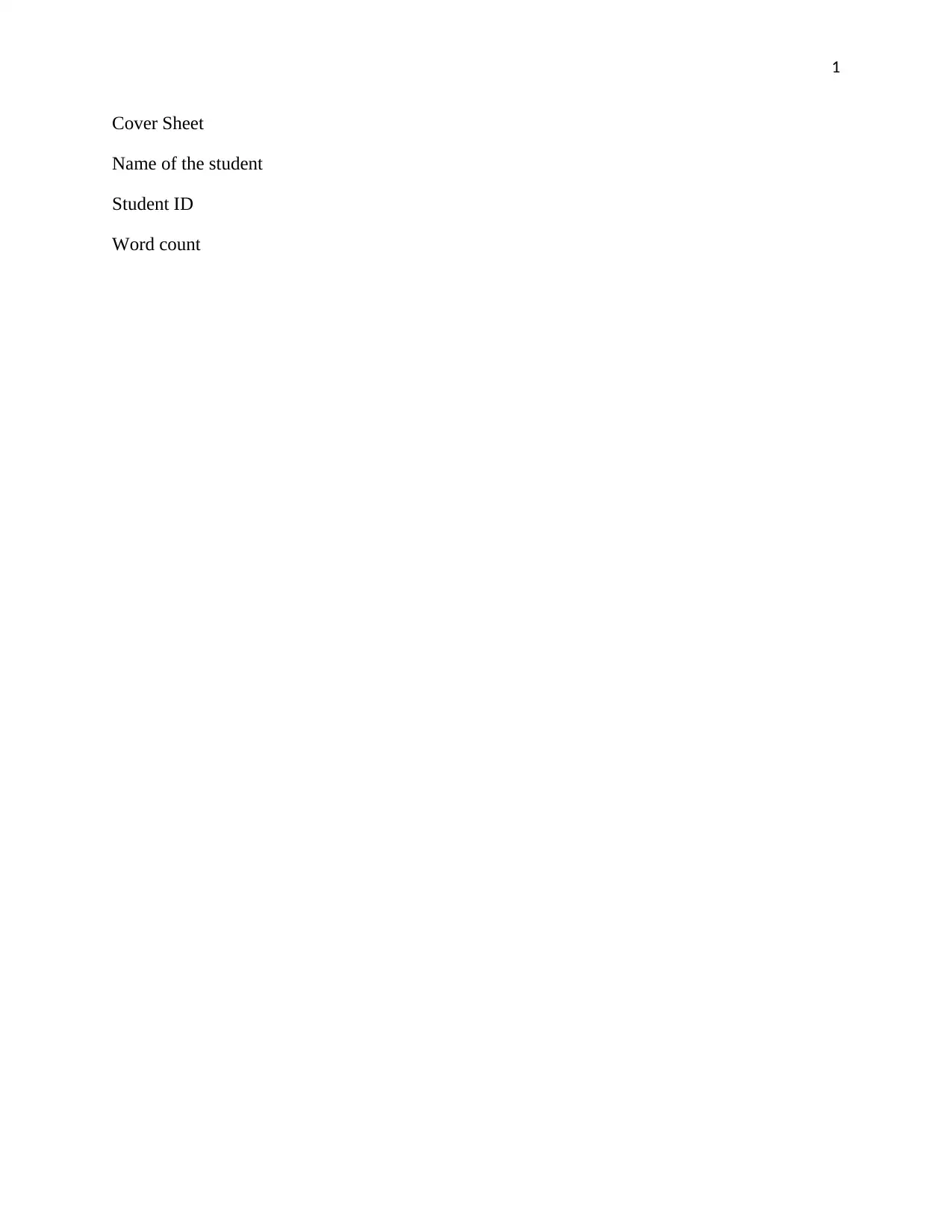
1
Cover Sheet
Name of the student
Student ID
Word count
Cover Sheet
Name of the student
Student ID
Word count
Paraphrase This Document
Need a fresh take? Get an instant paraphrase of this document with our AI Paraphraser

2
Contents
Assignment..................................................................................................................................................3
Issues A...................................................................................................................................................3
Applicable Law...................................................................................................................................3
Application of Law and conclusion.....................................................................................................3
Issue B.....................................................................................................................................................4
Applicable Law...................................................................................................................................4
Application of Law and conclusion.....................................................................................................5
Issue C.....................................................................................................................................................5
Applicable Law...................................................................................................................................5
Application of Law and conclusion.....................................................................................................5
Issue D.....................................................................................................................................................6
Applicable law.....................................................................................................................................6
Application of law and conclusion......................................................................................................6
Issue E.....................................................................................................................................................6
Applicable Law...................................................................................................................................6
Application of law and conclusion......................................................................................................7
Issue F.....................................................................................................................................................7
Applicable law.....................................................................................................................................7
Application of law and conclusion......................................................................................................7
Bibliography................................................................................................................................................9
Contents
Assignment..................................................................................................................................................3
Issues A...................................................................................................................................................3
Applicable Law...................................................................................................................................3
Application of Law and conclusion.....................................................................................................3
Issue B.....................................................................................................................................................4
Applicable Law...................................................................................................................................4
Application of Law and conclusion.....................................................................................................5
Issue C.....................................................................................................................................................5
Applicable Law...................................................................................................................................5
Application of Law and conclusion.....................................................................................................5
Issue D.....................................................................................................................................................6
Applicable law.....................................................................................................................................6
Application of law and conclusion......................................................................................................6
Issue E.....................................................................................................................................................6
Applicable Law...................................................................................................................................6
Application of law and conclusion......................................................................................................7
Issue F.....................................................................................................................................................7
Applicable law.....................................................................................................................................7
Application of law and conclusion......................................................................................................7
Bibliography................................................................................................................................................9
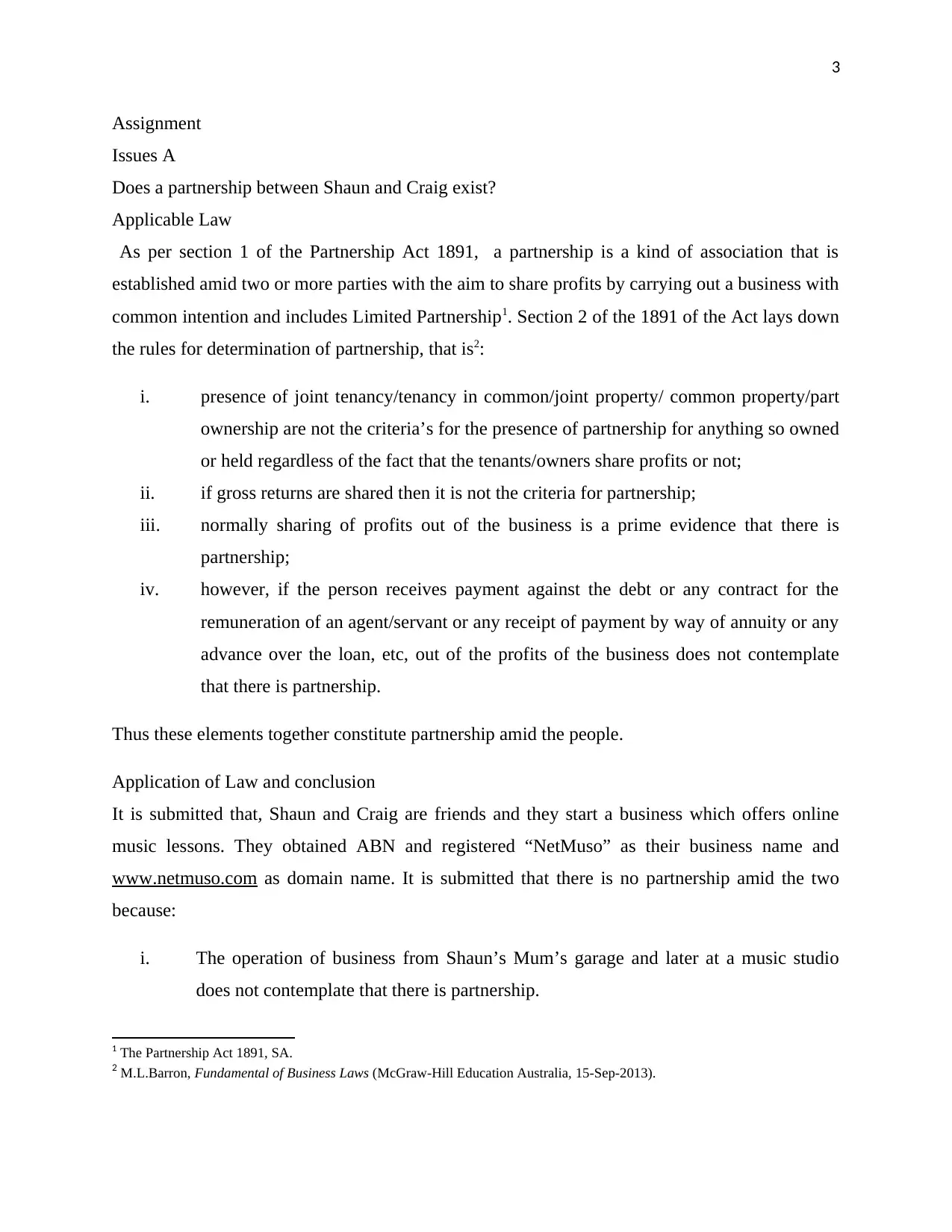
3
Assignment
Issues A
Does a partnership between Shaun and Craig exist?
Applicable Law
As per section 1 of the Partnership Act 1891, a partnership is a kind of association that is
established amid two or more parties with the aim to share profits by carrying out a business with
common intention and includes Limited Partnership1. Section 2 of the 1891 of the Act lays down
the rules for determination of partnership, that is2:
i. presence of joint tenancy/tenancy in common/joint property/ common property/part
ownership are not the criteria’s for the presence of partnership for anything so owned
or held regardless of the fact that the tenants/owners share profits or not;
ii. if gross returns are shared then it is not the criteria for partnership;
iii. normally sharing of profits out of the business is a prime evidence that there is
partnership;
iv. however, if the person receives payment against the debt or any contract for the
remuneration of an agent/servant or any receipt of payment by way of annuity or any
advance over the loan, etc, out of the profits of the business does not contemplate
that there is partnership.
Thus these elements together constitute partnership amid the people.
Application of Law and conclusion
It is submitted that, Shaun and Craig are friends and they start a business which offers online
music lessons. They obtained ABN and registered “NetMuso” as their business name and
www.netmuso.com as domain name. It is submitted that there is no partnership amid the two
because:
i. The operation of business from Shaun’s Mum’s garage and later at a music studio
does not contemplate that there is partnership.
1 The Partnership Act 1891, SA.
2 M.L.Barron, Fundamental of Business Laws (McGraw-Hill Education Australia, 15-Sep-2013).
Assignment
Issues A
Does a partnership between Shaun and Craig exist?
Applicable Law
As per section 1 of the Partnership Act 1891, a partnership is a kind of association that is
established amid two or more parties with the aim to share profits by carrying out a business with
common intention and includes Limited Partnership1. Section 2 of the 1891 of the Act lays down
the rules for determination of partnership, that is2:
i. presence of joint tenancy/tenancy in common/joint property/ common property/part
ownership are not the criteria’s for the presence of partnership for anything so owned
or held regardless of the fact that the tenants/owners share profits or not;
ii. if gross returns are shared then it is not the criteria for partnership;
iii. normally sharing of profits out of the business is a prime evidence that there is
partnership;
iv. however, if the person receives payment against the debt or any contract for the
remuneration of an agent/servant or any receipt of payment by way of annuity or any
advance over the loan, etc, out of the profits of the business does not contemplate
that there is partnership.
Thus these elements together constitute partnership amid the people.
Application of Law and conclusion
It is submitted that, Shaun and Craig are friends and they start a business which offers online
music lessons. They obtained ABN and registered “NetMuso” as their business name and
www.netmuso.com as domain name. It is submitted that there is no partnership amid the two
because:
i. The operation of business from Shaun’s Mum’s garage and later at a music studio
does not contemplate that there is partnership.
1 The Partnership Act 1891, SA.
2 M.L.Barron, Fundamental of Business Laws (McGraw-Hill Education Australia, 15-Sep-2013).
⊘ This is a preview!⊘
Do you want full access?
Subscribe today to unlock all pages.

Trusted by 1+ million students worldwide

4
ii. The lease if the studio is entered by Shaun alone with clarification that the properly is
lease out for a partnership business. also, as per section2 (1) (a), a joint tenancy also
does not indicate the presence if partnership;
iii. Shawn borrowed $20,000 from his Dad to pay the rental bond also does not indicate
partnership;
iv. The fees of the business is paid in the joint bank account does not establish that both
Shawn and Craig has decided to share profits and thus is not the resemblance of
partnership;
Thus, all the submissions establish that there is no presence of partnership amid Craig and
Shawn.
FOR ISSUES B-F, IT IS ASSUMED THAT A PARTNERSHIPS DOES EXIST.
Issue B
Can Craig leave the partnership in the way he did?
Applicable Law
Part 2, Division 4 of the Partnership Act 1891 defines as how a partnership must be dissolved.
As per section 32 of the Act if a partnership is required to be dissolved then the partner can do
so3:
i. If the partnership is for the term then after the expiration of the time period;
ii. If for a single adventure, upon expiration of the adventure;
iii. If there is no tie period then the partners must provide notice of the intention of the
dissolution. The partnership stands dissolve from the date mentioned upon the notice
or from the date when the notice is communicated.
As per section 41, if the partnership is dissolved by fraud, then, the aggrieved party has the right
to4:
3 Section 32 of the Partnership act 1891, Partnership Act 1891, < https://www.legislation.sa.gov.au/LZ/C/A/PARTNERSHIP
%20ACT%201891/CURRENT/1891.506.UN.PDF>.
4 Section 41 of the Partnership act 1891, Partnership Act 1891, < https://www.legislation.sa.gov.au/LZ/C/A/PARTNERSHIP
%20ACT%201891/CURRENT/1891.506.UN.PDF>.
ii. The lease if the studio is entered by Shaun alone with clarification that the properly is
lease out for a partnership business. also, as per section2 (1) (a), a joint tenancy also
does not indicate the presence if partnership;
iii. Shawn borrowed $20,000 from his Dad to pay the rental bond also does not indicate
partnership;
iv. The fees of the business is paid in the joint bank account does not establish that both
Shawn and Craig has decided to share profits and thus is not the resemblance of
partnership;
Thus, all the submissions establish that there is no presence of partnership amid Craig and
Shawn.
FOR ISSUES B-F, IT IS ASSUMED THAT A PARTNERSHIPS DOES EXIST.
Issue B
Can Craig leave the partnership in the way he did?
Applicable Law
Part 2, Division 4 of the Partnership Act 1891 defines as how a partnership must be dissolved.
As per section 32 of the Act if a partnership is required to be dissolved then the partner can do
so3:
i. If the partnership is for the term then after the expiration of the time period;
ii. If for a single adventure, upon expiration of the adventure;
iii. If there is no tie period then the partners must provide notice of the intention of the
dissolution. The partnership stands dissolve from the date mentioned upon the notice
or from the date when the notice is communicated.
As per section 41, if the partnership is dissolved by fraud, then, the aggrieved party has the right
to4:
3 Section 32 of the Partnership act 1891, Partnership Act 1891, < https://www.legislation.sa.gov.au/LZ/C/A/PARTNERSHIP
%20ACT%201891/CURRENT/1891.506.UN.PDF>.
4 Section 41 of the Partnership act 1891, Partnership Act 1891, < https://www.legislation.sa.gov.au/LZ/C/A/PARTNERSHIP
%20ACT%201891/CURRENT/1891.506.UN.PDF>.
Paraphrase This Document
Need a fresh take? Get an instant paraphrase of this document with our AI Paraphraser
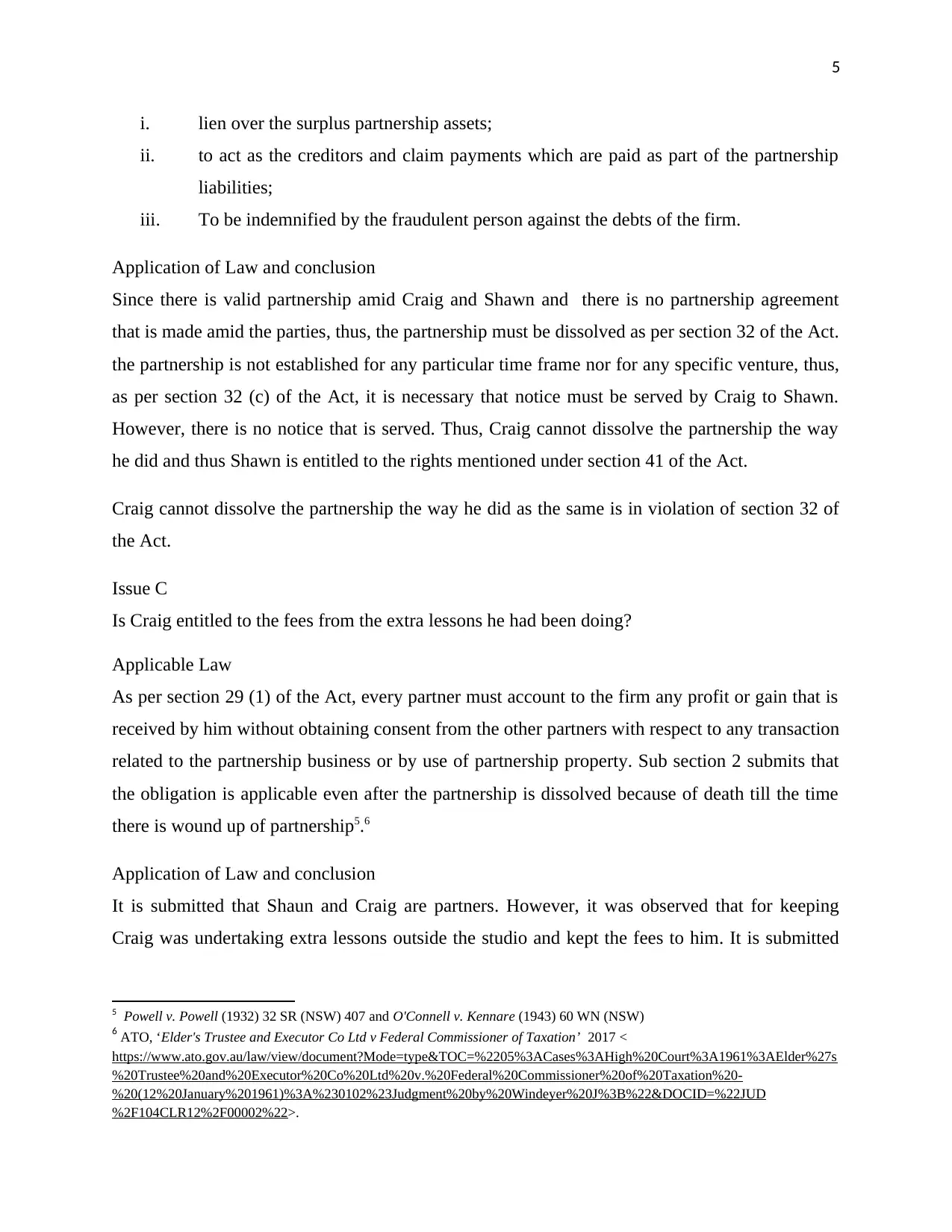
5
i. lien over the surplus partnership assets;
ii. to act as the creditors and claim payments which are paid as part of the partnership
liabilities;
iii. To be indemnified by the fraudulent person against the debts of the firm.
Application of Law and conclusion
Since there is valid partnership amid Craig and Shawn and there is no partnership agreement
that is made amid the parties, thus, the partnership must be dissolved as per section 32 of the Act.
the partnership is not established for any particular time frame nor for any specific venture, thus,
as per section 32 (c) of the Act, it is necessary that notice must be served by Craig to Shawn.
However, there is no notice that is served. Thus, Craig cannot dissolve the partnership the way
he did and thus Shawn is entitled to the rights mentioned under section 41 of the Act.
Craig cannot dissolve the partnership the way he did as the same is in violation of section 32 of
the Act.
Issue C
Is Craig entitled to the fees from the extra lessons he had been doing?
Applicable Law
As per section 29 (1) of the Act, every partner must account to the firm any profit or gain that is
received by him without obtaining consent from the other partners with respect to any transaction
related to the partnership business or by use of partnership property. Sub section 2 submits that
the obligation is applicable even after the partnership is dissolved because of death till the time
there is wound up of partnership5.6
Application of Law and conclusion
It is submitted that Shaun and Craig are partners. However, it was observed that for keeping
Craig was undertaking extra lessons outside the studio and kept the fees to him. It is submitted
5 Powell v. Powell (1932) 32 SR (NSW) 407 and O'Connell v. Kennare (1943) 60 WN (NSW)
6 ATO, ‘Elder's Trustee and Executor Co Ltd v Federal Commissioner of Taxation’ 2017 <
https://www.ato.gov.au/law/view/document?Mode=type&TOC=%2205%3ACases%3AHigh%20Court%3A1961%3AElder%27s
%20Trustee%20and%20Executor%20Co%20Ltd%20v.%20Federal%20Commissioner%20of%20Taxation%20-
%20(12%20January%201961)%3A%230102%23Judgment%20by%20Windeyer%20J%3B%22&DOCID=%22JUD
%2F104CLR12%2F00002%22>.
i. lien over the surplus partnership assets;
ii. to act as the creditors and claim payments which are paid as part of the partnership
liabilities;
iii. To be indemnified by the fraudulent person against the debts of the firm.
Application of Law and conclusion
Since there is valid partnership amid Craig and Shawn and there is no partnership agreement
that is made amid the parties, thus, the partnership must be dissolved as per section 32 of the Act.
the partnership is not established for any particular time frame nor for any specific venture, thus,
as per section 32 (c) of the Act, it is necessary that notice must be served by Craig to Shawn.
However, there is no notice that is served. Thus, Craig cannot dissolve the partnership the way
he did and thus Shawn is entitled to the rights mentioned under section 41 of the Act.
Craig cannot dissolve the partnership the way he did as the same is in violation of section 32 of
the Act.
Issue C
Is Craig entitled to the fees from the extra lessons he had been doing?
Applicable Law
As per section 29 (1) of the Act, every partner must account to the firm any profit or gain that is
received by him without obtaining consent from the other partners with respect to any transaction
related to the partnership business or by use of partnership property. Sub section 2 submits that
the obligation is applicable even after the partnership is dissolved because of death till the time
there is wound up of partnership5.6
Application of Law and conclusion
It is submitted that Shaun and Craig are partners. However, it was observed that for keeping
Craig was undertaking extra lessons outside the studio and kept the fees to him. It is submitted
5 Powell v. Powell (1932) 32 SR (NSW) 407 and O'Connell v. Kennare (1943) 60 WN (NSW)
6 ATO, ‘Elder's Trustee and Executor Co Ltd v Federal Commissioner of Taxation’ 2017 <
https://www.ato.gov.au/law/view/document?Mode=type&TOC=%2205%3ACases%3AHigh%20Court%3A1961%3AElder%27s
%20Trustee%20and%20Executor%20Co%20Ltd%20v.%20Federal%20Commissioner%20of%20Taxation%20-
%20(12%20January%201961)%3A%230102%23Judgment%20by%20Windeyer%20J%3B%22&DOCID=%22JUD
%2F104CLR12%2F00002%22>.
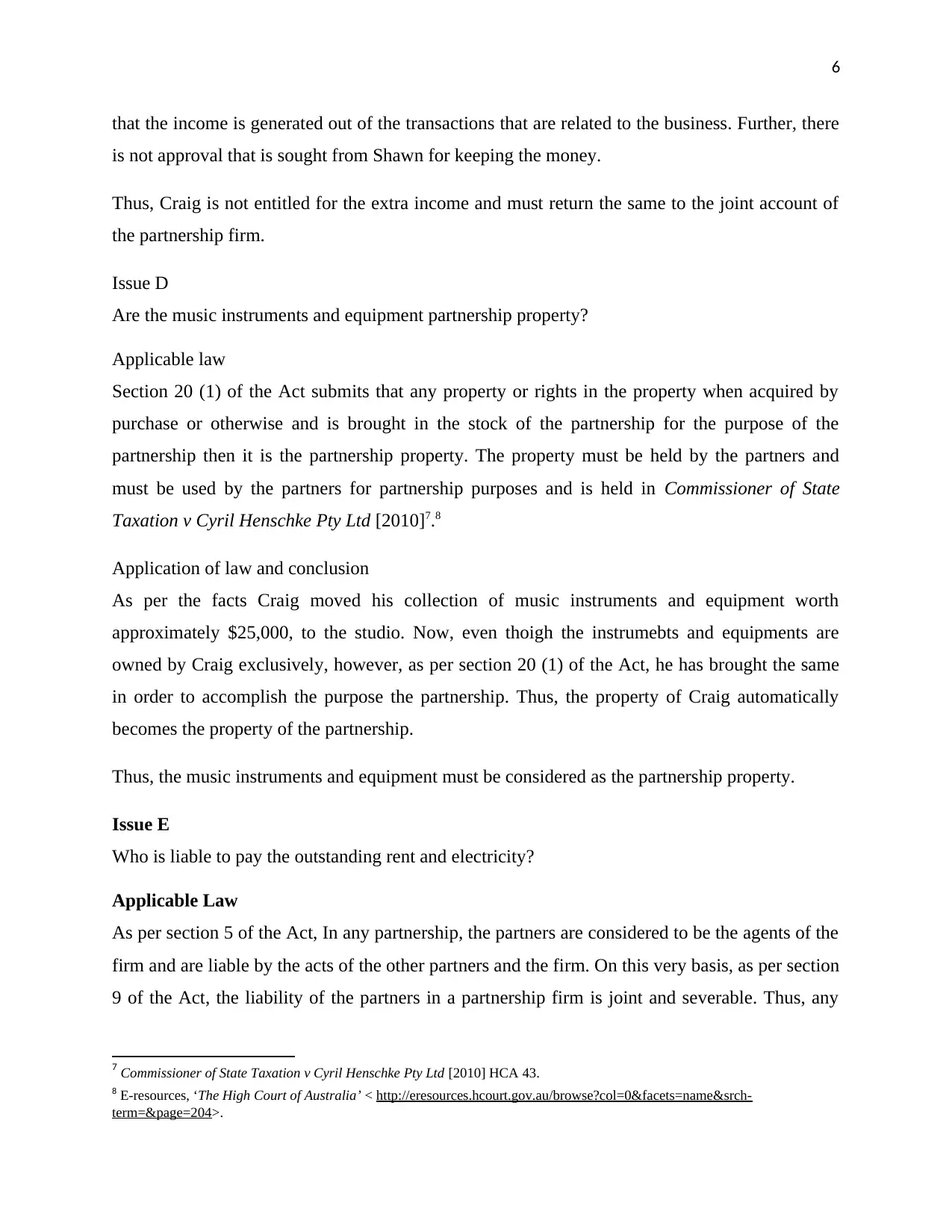
6
that the income is generated out of the transactions that are related to the business. Further, there
is not approval that is sought from Shawn for keeping the money.
Thus, Craig is not entitled for the extra income and must return the same to the joint account of
the partnership firm.
Issue D
Are the music instruments and equipment partnership property?
Applicable law
Section 20 (1) of the Act submits that any property or rights in the property when acquired by
purchase or otherwise and is brought in the stock of the partnership for the purpose of the
partnership then it is the partnership property. The property must be held by the partners and
must be used by the partners for partnership purposes and is held in Commissioner of State
Taxation v Cyril Henschke Pty Ltd [2010]7.8
Application of law and conclusion
As per the facts Craig moved his collection of music instruments and equipment worth
approximately $25,000, to the studio. Now, even thoigh the instrumebts and equipments are
owned by Craig exclusively, however, as per section 20 (1) of the Act, he has brought the same
in order to accomplish the purpose the partnership. Thus, the property of Craig automatically
becomes the property of the partnership.
Thus, the music instruments and equipment must be considered as the partnership property.
Issue E
Who is liable to pay the outstanding rent and electricity?
Applicable Law
As per section 5 of the Act, In any partnership, the partners are considered to be the agents of the
firm and are liable by the acts of the other partners and the firm. On this very basis, as per section
9 of the Act, the liability of the partners in a partnership firm is joint and severable. Thus, any
7 Commissioner of State Taxation v Cyril Henschke Pty Ltd [2010] HCA 43.
8 E-resources, ‘The High Court of Australia’ < http://eresources.hcourt.gov.au/browse?col=0&facets=name&srch-
term=&page=204>.
that the income is generated out of the transactions that are related to the business. Further, there
is not approval that is sought from Shawn for keeping the money.
Thus, Craig is not entitled for the extra income and must return the same to the joint account of
the partnership firm.
Issue D
Are the music instruments and equipment partnership property?
Applicable law
Section 20 (1) of the Act submits that any property or rights in the property when acquired by
purchase or otherwise and is brought in the stock of the partnership for the purpose of the
partnership then it is the partnership property. The property must be held by the partners and
must be used by the partners for partnership purposes and is held in Commissioner of State
Taxation v Cyril Henschke Pty Ltd [2010]7.8
Application of law and conclusion
As per the facts Craig moved his collection of music instruments and equipment worth
approximately $25,000, to the studio. Now, even thoigh the instrumebts and equipments are
owned by Craig exclusively, however, as per section 20 (1) of the Act, he has brought the same
in order to accomplish the purpose the partnership. Thus, the property of Craig automatically
becomes the property of the partnership.
Thus, the music instruments and equipment must be considered as the partnership property.
Issue E
Who is liable to pay the outstanding rent and electricity?
Applicable Law
As per section 5 of the Act, In any partnership, the partners are considered to be the agents of the
firm and are liable by the acts of the other partners and the firm. On this very basis, as per section
9 of the Act, the liability of the partners in a partnership firm is joint and severable. Thus, any
7 Commissioner of State Taxation v Cyril Henschke Pty Ltd [2010] HCA 43.
8 E-resources, ‘The High Court of Australia’ < http://eresources.hcourt.gov.au/browse?col=0&facets=name&srch-
term=&page=204>.
⊘ This is a preview!⊘
Do you want full access?
Subscribe today to unlock all pages.

Trusted by 1+ million students worldwide
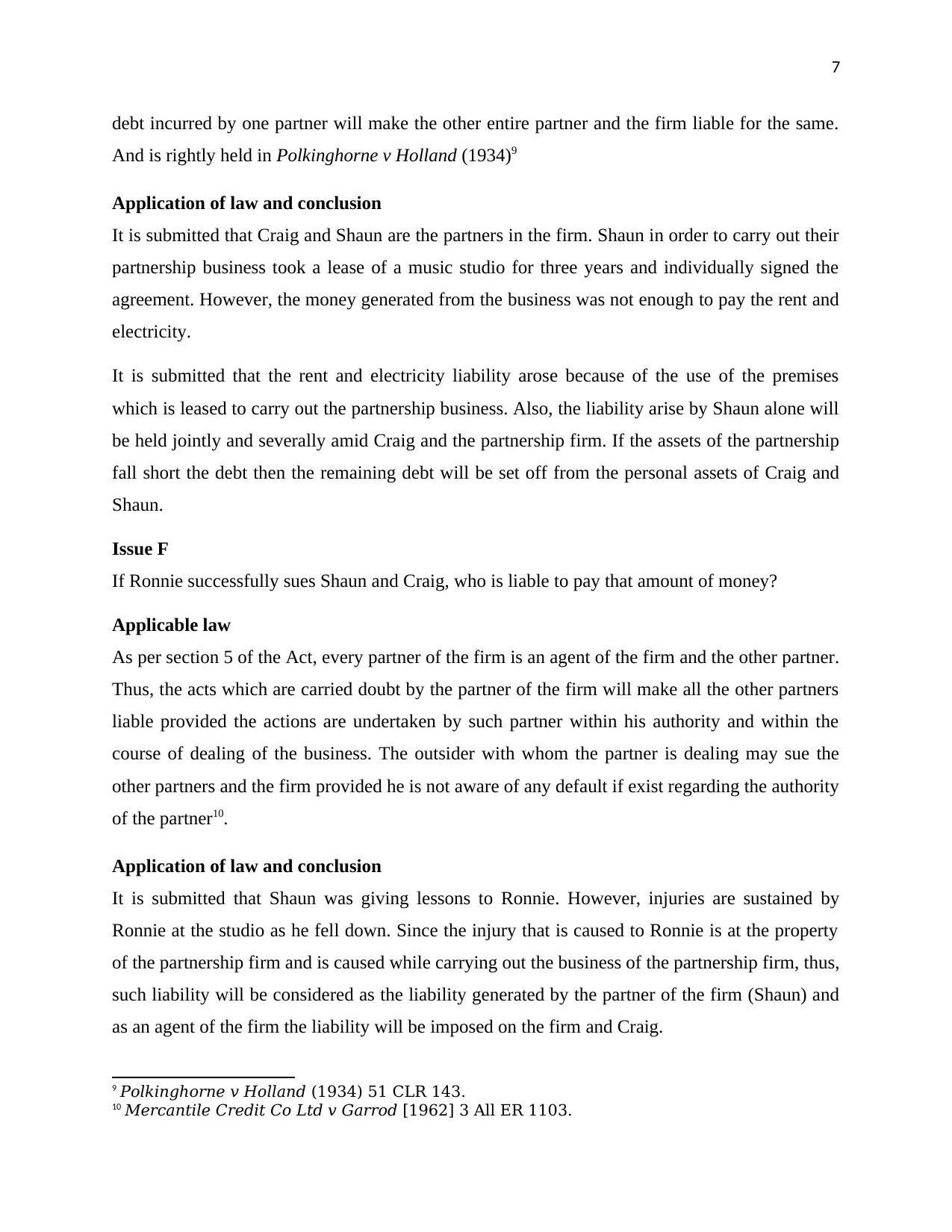
7
debt incurred by one partner will make the other entire partner and the firm liable for the same.
And is rightly held in Polkinghorne v Holland (1934)9
Application of law and conclusion
It is submitted that Craig and Shaun are the partners in the firm. Shaun in order to carry out their
partnership business took a lease of a music studio for three years and individually signed the
agreement. However, the money generated from the business was not enough to pay the rent and
electricity.
It is submitted that the rent and electricity liability arose because of the use of the premises
which is leased to carry out the partnership business. Also, the liability arise by Shaun alone will
be held jointly and severally amid Craig and the partnership firm. If the assets of the partnership
fall short the debt then the remaining debt will be set off from the personal assets of Craig and
Shaun.
Issue F
If Ronnie successfully sues Shaun and Craig, who is liable to pay that amount of money?
Applicable law
As per section 5 of the Act, every partner of the firm is an agent of the firm and the other partner.
Thus, the acts which are carried doubt by the partner of the firm will make all the other partners
liable provided the actions are undertaken by such partner within his authority and within the
course of dealing of the business. The outsider with whom the partner is dealing may sue the
other partners and the firm provided he is not aware of any default if exist regarding the authority
of the partner10.
Application of law and conclusion
It is submitted that Shaun was giving lessons to Ronnie. However, injuries are sustained by
Ronnie at the studio as he fell down. Since the injury that is caused to Ronnie is at the property
of the partnership firm and is caused while carrying out the business of the partnership firm, thus,
such liability will be considered as the liability generated by the partner of the firm (Shaun) and
as an agent of the firm the liability will be imposed on the firm and Craig.
9 Polkinghorne v Holland (1934) 51 CLR 143.
10 Mercantile Credit Co Ltd v Garrod [1962] 3 All ER 1103.
debt incurred by one partner will make the other entire partner and the firm liable for the same.
And is rightly held in Polkinghorne v Holland (1934)9
Application of law and conclusion
It is submitted that Craig and Shaun are the partners in the firm. Shaun in order to carry out their
partnership business took a lease of a music studio for three years and individually signed the
agreement. However, the money generated from the business was not enough to pay the rent and
electricity.
It is submitted that the rent and electricity liability arose because of the use of the premises
which is leased to carry out the partnership business. Also, the liability arise by Shaun alone will
be held jointly and severally amid Craig and the partnership firm. If the assets of the partnership
fall short the debt then the remaining debt will be set off from the personal assets of Craig and
Shaun.
Issue F
If Ronnie successfully sues Shaun and Craig, who is liable to pay that amount of money?
Applicable law
As per section 5 of the Act, every partner of the firm is an agent of the firm and the other partner.
Thus, the acts which are carried doubt by the partner of the firm will make all the other partners
liable provided the actions are undertaken by such partner within his authority and within the
course of dealing of the business. The outsider with whom the partner is dealing may sue the
other partners and the firm provided he is not aware of any default if exist regarding the authority
of the partner10.
Application of law and conclusion
It is submitted that Shaun was giving lessons to Ronnie. However, injuries are sustained by
Ronnie at the studio as he fell down. Since the injury that is caused to Ronnie is at the property
of the partnership firm and is caused while carrying out the business of the partnership firm, thus,
such liability will be considered as the liability generated by the partner of the firm (Shaun) and
as an agent of the firm the liability will be imposed on the firm and Craig.
9 Polkinghorne v Holland (1934) 51 CLR 143.
10 Mercantile Credit Co Ltd v Garrod [1962] 3 All ER 1103.
Paraphrase This Document
Need a fresh take? Get an instant paraphrase of this document with our AI Paraphraser
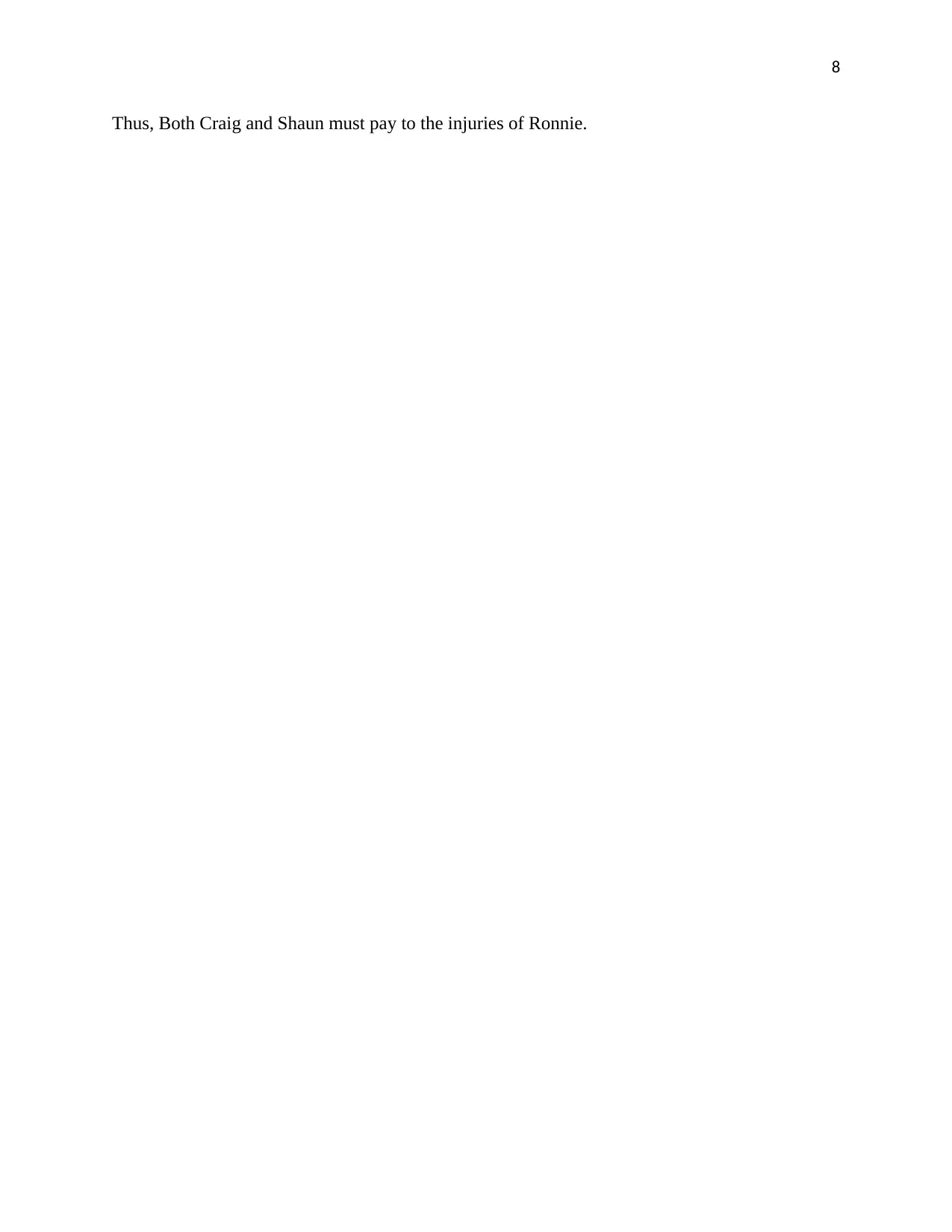
8
Thus, Both Craig and Shaun must pay to the injuries of Ronnie.
Thus, Both Craig and Shaun must pay to the injuries of Ronnie.
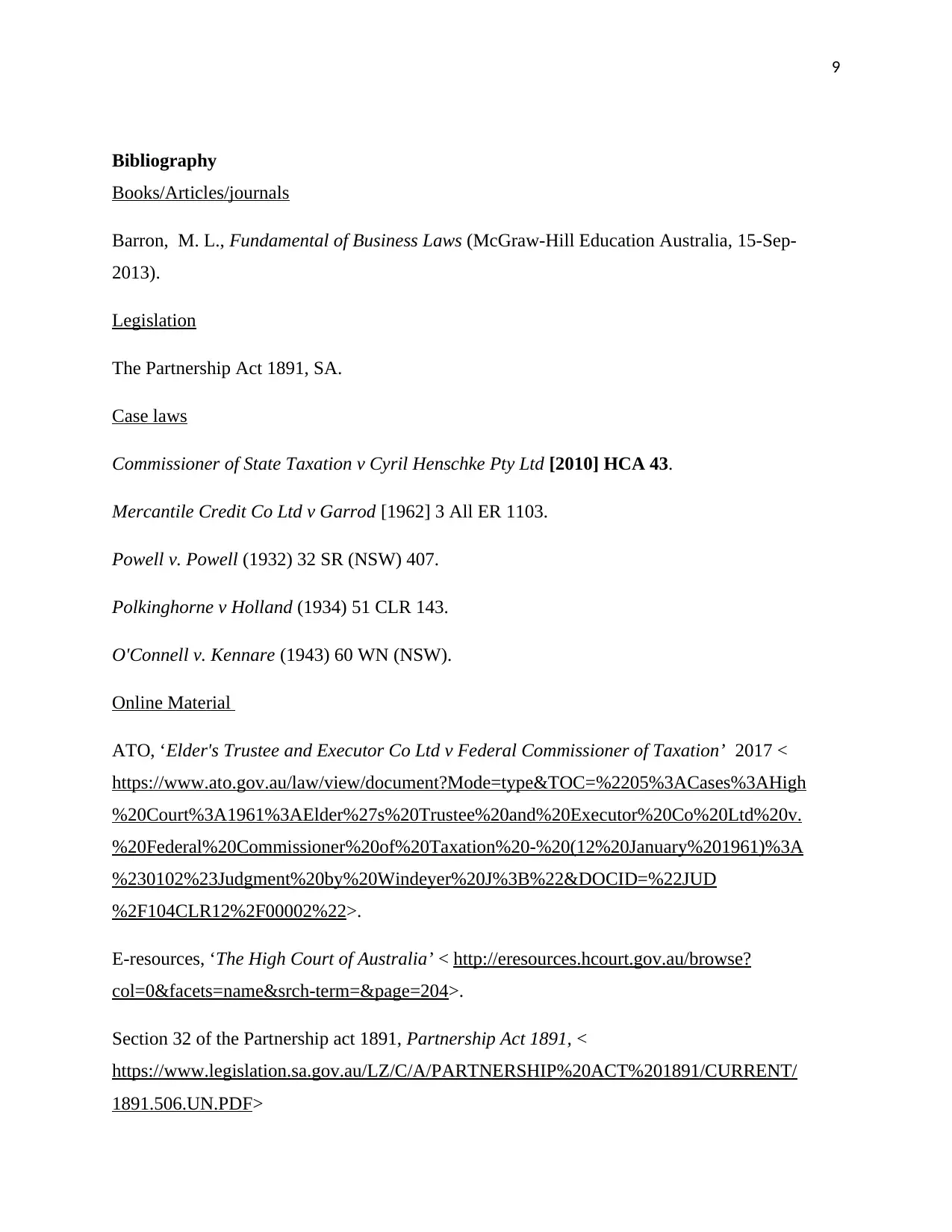
9
Bibliography
Books/Articles/journals
Barron, M. L., Fundamental of Business Laws (McGraw-Hill Education Australia, 15-Sep-
2013).
Legislation
The Partnership Act 1891, SA.
Case laws
Commissioner of State Taxation v Cyril Henschke Pty Ltd [2010] HCA 43.
Mercantile Credit Co Ltd v Garrod [1962] 3 All ER 1103.
Powell v. Powell (1932) 32 SR (NSW) 407.
Polkinghorne v Holland (1934) 51 CLR 143.
O'Connell v. Kennare (1943) 60 WN (NSW).
Online Material
ATO, ‘Elder's Trustee and Executor Co Ltd v Federal Commissioner of Taxation’ 2017 <
https://www.ato.gov.au/law/view/document?Mode=type&TOC=%2205%3ACases%3AHigh
%20Court%3A1961%3AElder%27s%20Trustee%20and%20Executor%20Co%20Ltd%20v.
%20Federal%20Commissioner%20of%20Taxation%20-%20(12%20January%201961)%3A
%230102%23Judgment%20by%20Windeyer%20J%3B%22&DOCID=%22JUD
%2F104CLR12%2F00002%22>.
E-resources, ‘The High Court of Australia’ < http://eresources.hcourt.gov.au/browse?
col=0&facets=name&srch-term=&page=204>.
Section 32 of the Partnership act 1891, Partnership Act 1891, <
https://www.legislation.sa.gov.au/LZ/C/A/PARTNERSHIP%20ACT%201891/CURRENT/
1891.506.UN.PDF>
Bibliography
Books/Articles/journals
Barron, M. L., Fundamental of Business Laws (McGraw-Hill Education Australia, 15-Sep-
2013).
Legislation
The Partnership Act 1891, SA.
Case laws
Commissioner of State Taxation v Cyril Henschke Pty Ltd [2010] HCA 43.
Mercantile Credit Co Ltd v Garrod [1962] 3 All ER 1103.
Powell v. Powell (1932) 32 SR (NSW) 407.
Polkinghorne v Holland (1934) 51 CLR 143.
O'Connell v. Kennare (1943) 60 WN (NSW).
Online Material
ATO, ‘Elder's Trustee and Executor Co Ltd v Federal Commissioner of Taxation’ 2017 <
https://www.ato.gov.au/law/view/document?Mode=type&TOC=%2205%3ACases%3AHigh
%20Court%3A1961%3AElder%27s%20Trustee%20and%20Executor%20Co%20Ltd%20v.
%20Federal%20Commissioner%20of%20Taxation%20-%20(12%20January%201961)%3A
%230102%23Judgment%20by%20Windeyer%20J%3B%22&DOCID=%22JUD
%2F104CLR12%2F00002%22>.
E-resources, ‘The High Court of Australia’ < http://eresources.hcourt.gov.au/browse?
col=0&facets=name&srch-term=&page=204>.
Section 32 of the Partnership act 1891, Partnership Act 1891, <
https://www.legislation.sa.gov.au/LZ/C/A/PARTNERSHIP%20ACT%201891/CURRENT/
1891.506.UN.PDF>
⊘ This is a preview!⊘
Do you want full access?
Subscribe today to unlock all pages.

Trusted by 1+ million students worldwide

10
Section 41 of the Partnership act 1891, Partnership Act 1891, <
https://www.legislation.sa.gov.au/LZ/C/A/PARTNERSHIP%20ACT%201891/CURRENT/
1891.506.UN.PDF>
Section 41 of the Partnership act 1891, Partnership Act 1891, <
https://www.legislation.sa.gov.au/LZ/C/A/PARTNERSHIP%20ACT%201891/CURRENT/
1891.506.UN.PDF>
1 out of 10
Related Documents
Your All-in-One AI-Powered Toolkit for Academic Success.
+13062052269
info@desklib.com
Available 24*7 on WhatsApp / Email
![[object Object]](/_next/static/media/star-bottom.7253800d.svg)
Unlock your academic potential
Copyright © 2020–2025 A2Z Services. All Rights Reserved. Developed and managed by ZUCOL.




